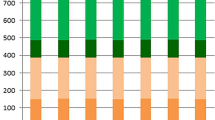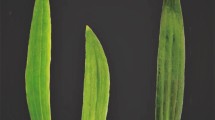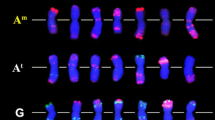Abstract
The cultivation of the first filial generation of monoploid gametophyte clones of different Laminaria species (hybrid Laminaria) is an effective way of utilizing heterozygous vigor (heterosis). A female gametophyte clone of L. japonica and a male gametophyte clone of L. longissima were hybridized, generating Dongfang No.2 hybrid Laminaria. The parentage of this hybrid Laminaria was determined using AFLP of total DNA, SNP of the ITS region of ribosomal RNA transcription unit and microsatellite DNA variation at two loci. In addition to 167 AFLP bands shared by Dongfang No.2, L. japonica and L. longissima, Dongfang No.2 hybrid Laminaria shared another 70 and 55 bands with L. japonica and L. longissima, respectively, which were obviously more than 11 bands shared by L. japonica and L. longissima. Dongfang No.2 held both ‘T’ and ‘C’ at position 847 of the ITS region, while ‘T’ at this position was specific for L. japonica and ‘C’ for L. longissima, respectively. Dongfang No.2 also held the microsatellite DNA alleles of two parents together at two microsatellite DNA marker loci. These observations clearly proved that Dongfang No.2 is a true hybrid of L. japonica and L. longissiuma. Unfortunately, the origin of the chloroplast of Dongfang No.2 was not determined based on the variation of RuBisCo spacer. More sequence variants of both ITS region and RuBisCo spacer were identified in Dongfang No.2 and most of them did not exist in either L. japonica or L. longissima. The unexpected variants may be due to the mutation of gametophyte clones occurring during their vegetative amplification.
Similar content being viewed by others
References
Aguilar, J. F., J. A. Rossello, and G. N. Feliner, 1999. Nuclear ribosomal DNA (nrDNA) concerted evolution in natural and artificial hybrids of Armeria (Plumbaginaceae). Mol. Biol., 8: 1341–1346.
Ganley, A. R. D., and B. Scott, 2002. Concerted evolution in the ribosomal RNA genes of an Epichloe endophyte hybrid: Comparison between tandemly arranged rDNA and dispersed 5S rrn genes. Fungal Genet. Biol., 35: 39–51.
Druehl, L. D., J. D. Collins, C. E. Lane, and G. W. Saunders, 2005. An evaluation of methods used to assess intergenic hybridization in Laminaria using pacific Laminarials (Phaeophyceae). J. Phycol., 41: 250–262.
Fang, Z., Y. Ou, and J. Cui, 1985. Breeding of hybrid Laminaria ‘Danza No. 10’: An application of the Laminaria haploid cell clones. J. Shangdong Col. Oceanol., 15(1): 64–72 (in Chinese with English abstract).
Fang, Z., Y. Ou, and J. Cui, 1983. Experiments on heterosis of Laminaria. Mar. Sci. Bull., 23(6): 57–60 (in Chinese with English abstract).
Fang, Z., Y. Ou, and J. Cui, 1978. Success in culturing clones of the gametophytes of Laminaria japonica. Transac. Sci., 2: 115–116 (in Chinese with English abstract).
Fang, T. C., C. Y. Wu, B. Y. Jiang, T. T. Li, and G. Z. Ren, 1962. The breeding of a new breed of Haidai (Laminaria japonica Aresch.) and its preliminary genetic analysis. Acta Botanica Sinica, 10(3): 197–209 (in Chinese with English abstract).
Lane, C. E., C. Mayes, L. D. Druehl, and G. W. Saunders, 2006. A multi-gene molecular investigation of the Laminaria (Laminarials, Phaeophyceae) supports substantial taxonomic re-organization. J. Phycol., 42: 493–512.
Li, X. J., Y. Z. Cong, G. P. Yang, S. C. Qu, Z. L. Li, G. W. Wang, et al., 2007. Trait evaluation and trial cultivation of Dongfang No.2, the hybrid of a male gametophyte clone of Laminaria longissima (Laminariales, Phaeophyta) and a female one of L. japonica. J. Appl. Phycol., 19: 139–151.
Li, D., Y. Lu, and C. Wu, 2002. History and current status of Laminaria breeding and sporeling raising technology. Biol. Bull., 37(8): 1–3 (in Chinese).
Li, D., Z. Zhou, H. Liu, and C. Wu, 1999. A new method of Laminaria japonica strain selection and sporeling raising by the use of gametophyte clones. Hydrobiologia, 398/399: 473–476.
Li, H. J., 1990. Notes on the Lanimaria raft cultivation method. Mariculture, 1/2: 41–48 (in Chinese).
Ou, Y., J. Cui, and Z. Fang, 1983. Experiment of Laminaria heterosis. Mar. Sci. Bull., 2(6): 57–61 (in Chinese with English abstract).
Patwary, M. U., and M. M. Ron, 1993. Revealing genetic markers on Gelidium vagum (Rhodophyta) through the random amplified polymorphic DNA (RAPD) technique. J. Phycol., 19(2): 216–222.
Schlotterer, C., and D. Tautz, 1994. Chromosomal homogeneity of Drosophila ribosomal DNA arrays suggests intrachromosomal exchanges drive concerted evolution. Curr. Biol., 4: 777–783.
Scoggan, S., Z. Zhuang, and F. Wang, 1989. Laminaria Seafarming in China: Training Manual 89/5 (RAS/86/024). Qingdao, China.
Tian, Z., and B. Yuan, 1989. Report of the breeding of a novel Laminaria variety, Zaohoucheng No.1. Mariculture, 1: 7–17 (in Chinese).
Tseng, C. K., 2001. Algal biotechnology industries and research activities in China. J. Appl. Phycol., 13: 375–380.
Tseng, C. K., K. Y. Sun, and C. Y. Wu, 1955. On the cultivation of Haidai (Laminaria japonica Aresch) by summering young sporophytes at low temperature. Acta Botanica Sinica, 4(3): 255–264 (in Chinese with English abstract).
Vos, P., R. Hogers, M. Bleeker, M. Reijans, T. van de Lee, M. Hornes, et al., 1995. AFLP: a new technique for DNA fingerprinting. Nucleic Acids Res., 23(21): 4407–4414.
Wang, S. 1994. Seaweed Biotechnology. Shanghai Scientific & Technical Publishers, Shanghai, China, 104–111 (in Chinese).
Yoon, H. S., J. Y. Lee, S. M. Boo, and D. Bhattacharya, 2001. Phylogeny of Alariaceae, Laminariaceae, and Lessoniaceae (Phaeophyceae) based on plastid-encoded RuBisCo spacer and nuclear-encoded ITS sequence comparison. Mol. Phylogenet. Evol., 21(2): 231–243.
Yoon, H. S., and S. M. Boo, 1999. Phylogeny of Alariaceae (Phaeophyta) with special reference to Undaria based on sequences of the RuBisCo spacer region. Hydrobiologia, 398/399: 47–55.
Yotsukura, N., T. Denboh, T. Motomura, T. Horiguchi, A. W. Coleman, and T. Ichimura, 1999. Little divergence in ribosomal DNA internal transcribed spacer-1 and-2 sequences among non-digitate species of Laminaria (Phaeophyceae) from Hokkaido, Japan. Phycol. Res., 47: 71–80.
Zane, L., L. Bargelloni, and T. Patarnello, (2002) Strategies for microsatellite isolation: a review. Mol. Ecol., 11: 1–16.
Zemke-White, W. L., and M. Ohno, 1999. World seaweed utilization: An end-of-century summary. J. Appl. Phycol., 11: 369–376.
Zhang, Q., X. Tang, P. Zhang, S. Qu, and X. Li, 2005. Study on the seedling collection technology in the production of Laminaria gametophyte clone. High Tech. Lett., 15(1): 89–92 (in Chinese with English abstract).
Zhang, Q. S., S. P. Liu, S. C. Qu, Z. P. Tian, Z. M. Guo, Y. Z. Cong, et al., 2001. Studies on rearing new variety of Laminaria 901. Transac. Oceanol. Limnol., 2: 46–53 (in Chinese with English abstract).
Author information
Authors and Affiliations
Corresponding author
Rights and permissions
About this article
Cite this article
Shi, Y., Yang, G., Liao, M. et al. Parentage analysis of Dongfang No.2, a hybrid of a female gametophyte clone of Laminaria japonica (Laminariales, Phaeophyta) and a male clone of L. longissima . J. Ocean Univ. China 7, 193–198 (2008). https://doi.org/10.1007/s11802-008-0193-z
Received:
Accepted:
Published:
Issue Date:
DOI: https://doi.org/10.1007/s11802-008-0193-z




